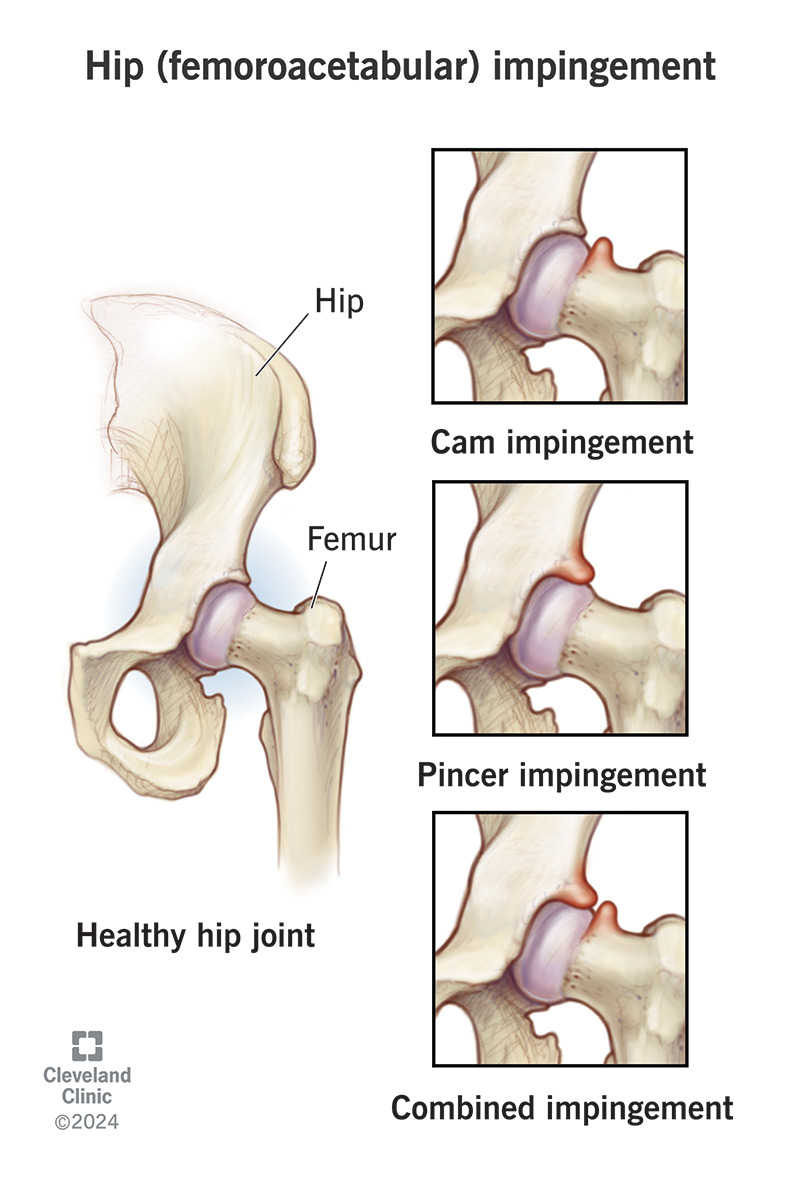Hip impingement is painful pinching or rubbing inside your hip joint. It happens when your hip’s natural shape creates extra friction that prevents it from moving as smoothly as it should. Treatments include physical therapy, pain medications and surgery to repair and reshape your hip bones.
Advertisement
Cleveland Clinic is a non-profit academic medical center. Advertising on our site helps support our mission. We do not endorse non-Cleveland Clinic products or services. Policy

Hip impingement is painful pinching that happens when the bones in your hip don’t fit together like they should. Healthcare providers also call it femoroacetabular impingement or FAI.
Advertisement
Cleveland Clinic is a non-profit academic medical center. Advertising on our site helps support our mission. We do not endorse non-Cleveland Clinic products or services. Policy
FAI is painful. It can make it hard to walk or move. You might feel stiff or sore all the time on one side. Over time, the impingement can damage the cartilage that cushions your hip joint.
Visit a healthcare provider if you’re experiencing hip pain, stiffness or other symptoms that don’t get better in a week or two.
Healthcare providers classify hip impingement as one of three types. Each type is based on why your hip doesn’t fit together like it should:
The most common femoroacetabular impingement symptoms include:
Some people with FAI never experience symptoms. You might notice worsening symptoms over time. This is especially true if impingement damages the cartilage in your hip joint.
Hip impingement usually feels like a constant, dull ache in your hip. The pain might spread to your:
It might feel like there’s a bruise deep inside your body that someone is constantly pressing on.
FAI pain typically gets worse during physical activities. You may notice it more during motions like:
Advertisement
Lying on your side or sitting still for a long time can also make the pain worse. These activities or positions can make the pain feel sharp or stabbing.
FAI happens when the bones in your hip joint rub, catch or put extra pressure on each other. It’s usually because of a bone spur on your thigh bone or in your hip socket. Most people with unusually shaped joints are born with them. Bone spurs can develop throughout your life.
Anyone can be born with or develop hip impingement. Males are more likely to have cam impingement. Females are more likely to have pincer or combined impingement.
Athletes are more likely to experience symptoms. Especially if they play sports that put lots of pressure on their hips. This doesn’t mean that playing sports makes you more likely to develop impingement. But athletes are more likely to notice symptoms. That’s because they use their hips more often and more intensely than most people.
Hip impingement can damage your hip joint if it’s not treated. The most common complications include:
A healthcare provider will diagnose FAI with a physical exam and imaging tests. Tell your provider when you first noticed symptoms. Let them know if any movements, activities or positions make the symptoms better or worse.
Your provider will use imaging tests to take pictures of your hip. These tests may include:
Your provider may inject a small amount of local anesthetic into your hip to numb it. The medication might temporarily relieve symptoms. This can be a sign you have FAI. They may use other medications to manage hip impingement. But this is usually a good way to help diagnose it.
An FAI test will help your provider check for hip impingement. You’ll lie on your back, and your provider will lift your leg up toward your chest. Then, you’ll bend your knee so your leg forms an L shape. Your provider will twist your upper leg in, toward the center of your body.
These positions let your provider put light pressure in places you might have FAI. You might have hip impingement if you feel pain during these movements. The test may be uncomfortable. But it’s safe. Tell your provider if you feel any severe pain during the test.
Common femoroacetabular impingement treatments include:
Advertisement
Visit a healthcare provider if you’re experiencing FAI symptoms for more than a few weeks. Tell your provider if the symptoms make it hard to move or use your hip.
Talk to your provider if treatments like NSAIDs or physical therapy aren’t working as well as they used to.
FAI won’t go away unless you have surgery to correct the shape of your hip. But most people can manage symptoms with other treatments.
Advertisement
Talk to your provider about which treatments are right for you. Ask them when you should consider surgery.
Surgery to repair femoroacetabular impingement has a very high success rate. Many people have no long-term side effects. You might have to avoid or modify certain exercises or movements. But you should still be able to stay active and play sports.
Finding out you have hip impingement can be a relief — finally, you know why your hip’s been aching for so long. But it can also be frustrating — there’s nothing you could’ve done to prevent it, and it happened because of the way your hip bones naturally developed.
No matter what you’re feeling, FAI responds well to treatment. It might take a while to find a way to manage your symptoms, but your provider will help you tweak and modify things until something works. If you do end up needing surgery, remember that hip arthroscopy is minimally invasive and very successful.
Advertisement
From sudden injuries to chronic conditions, Cleveland Clinic’s orthopaedic providers can guide you through testing, treatment and beyond.

Last reviewed on 06/19/2025.
Learn more about the Health Library and our editorial process.